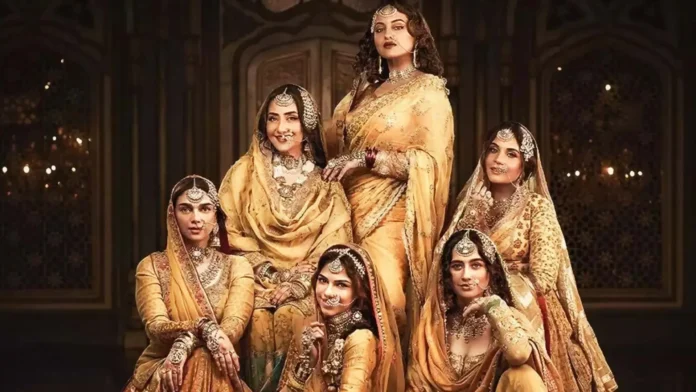Exploring the Cultural Enigma Tawaif Tradition in ‘Heeramandi.
1 min read 2024-05-01, 05:20 PM IST
|
Synopsis The tawaif culture in the Mughal era, as portrayed in “Heera Mandi,” distinguishes itself from prostitution by emphasizing refinement, intellect, and artistic talent. Tawaifs were revered entertainers in aristocratic circles, celebrated for their contributions to music, dance, and poetry. Sanjay Leela Bhansali’s visual mastery promises to authentically recreate this opulent world, offering viewers a glimpse into a bygone era of elegance and sophistication. “Heera Mandi” holds the anticipation of not just a visual spectacle but also a thoughtful exploration of a cultural phenomenon steeped in history and intrigue. |
It seems like you’re discussing the portrayal of the tawaif culture in the Mughal era, particularly in the context of the upcoming show “Heera Mandi.” You’re pointing out the distinction between a tawaif and a prostitute, highlighting the cultural significance and historical context surrounding the tawaif tradition.
A tawaif was not just a prostitute but a highly trained and skilled entertainer, often associated with refinement, culture, and artistic talent. They were patronized by nobility and played a significant role in the cultural and social life of that era. The tawaif culture was deeply ingrained in the aristocratic circles, where they were respected for their artistic abilities, education, and refinement.
The discussion also touches upon the aesthetic and visual brilliance of Sanjay Leela Bhansali’s work, particularly in his ability to create visually stunning settings and costumes. The anticipation for “Heera Mandi” seems to stem from the expectation of seeing this rich historical and cultural backdrop brought to life on screen.
Overall, it seems like you’re intrigued by the potential of “Heera Mandi” to delve into the complexities of the tawaif culture and to showcase the visual splendor associated with that era, all while maintaining authenticity and historical accuracy.
New Global Update- your speediest source for breaking news! READ NOW →
The portrayal of the tawaif culture in the Mughal era, particularly within the context of the eagerly awaited show “Heera Mandi,” is a topic that stirs intrigue and curiosity. Central to this discussion is the nuanced difference between a tawaif and a prostitute, a distinction often blurred in common discourse but profoundly significant in historical and cultural contexts.
In the vivid tapestry of Mughal society, the tawaif occupied a distinct and revered position. Unlike a mere prostitute, a tawaif was a multifaceted individual, embodying not just physical allure but also intellectual acumen, artistic talent, and refined etiquette. Trained rigorously in the arts of dance, music, poetry, and conversation, the tawaif was a paragon of sophistication and cultural refinement. Their presence graced the courts of nobility, where they entertained and enchanted with their performances, captivating hearts and minds alike. (also read: Tamil Actor Daniel Balaji Passes Away at 48 Due to Heart Attack).
Crucially, the tawaif was not merely a provider of physical pleasure but a purveyor of cultural enrichment. Their company was sought after not just for carnal desires but also for intellectual stimulation and social engagement. In the vibrant salons of the Mughal elite, tawaifs held sway as esteemed companions, engaging in erudite discourse and artistic exchange with poets, scholars, and aristocrats.
The tawaif’s role extended beyond mere entertainment; they were custodians of tradition and culture, preserving and propagating art forms that were integral to the fabric of Mughal society. Through their performances and patronage, they enriched the cultural landscape, nurturing the flourishing of music, dance, and poetry in the royal courts and beyond.(also read: Movie Review: “Crew”).
It is essential to understand the historical context surrounding the tawaif culture. In the Mughal era, tawaifs enjoyed a status that transcended mere profession; they were revered as symbols of refinement and cultural sophistication. Far from being marginalized or stigmatized, they were celebrated and respected for their artistic talents and intellectual prowess.
“Heera Mandi” promises to provide a nuanced and authentic portrayal of this fascinating epoch in history. With Sanjay Leela Bhansali at the helm, known for his impeccable attention to detail and visual grandeur, the show holds the promise of transporting viewers to the opulent world of Mughal courtesans. Bhansali’s mastery in creating visually stunning settings and intricate costumes sets the stage for a captivating narrative that delves into the complexities of tawaif life.
The anticipation surrounding “Heera Mandi” is palpable, fueled by the prospect of witnessing the rich tapestry of Mughal culture come to life on screen. From the intricacies of courtly etiquette to the melodious strains of classical music, every aspect of tawaif culture is poised to be authentically recreated, offering viewers a glimpse into a bygone era of elegance and refinement.
As audiences eagerly await the unveiling of “Heera Mandi,” they anticipate not just a visual spectacle but a thoughtful exploration of a cultural phenomenon that continues to intrigue and fascinate. In revisiting the tawaif tradition, the show has the opportunity to shed light on a complex and often misunderstood aspect of history, inviting viewers to immerse themselves in a world of beauty, passion, and intrigue.


